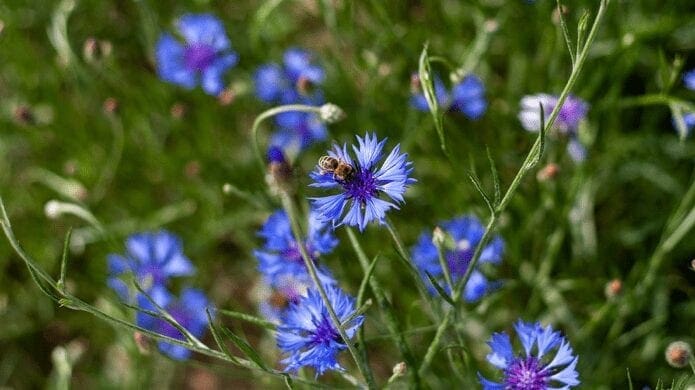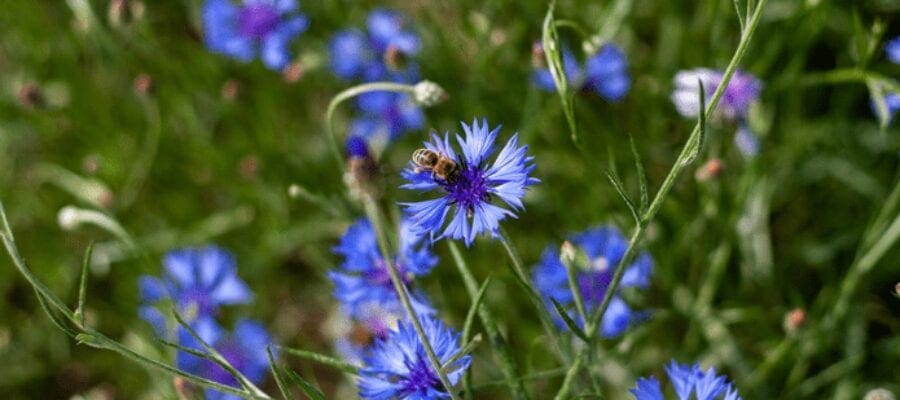A new plan has been launched by insect charity Buglife to help pollinating insects by creating a ‘bee motorway’ across the UK.
Landowners have joined together to plant pollinator-friendly flowers to create a highway that bees can travel on – and it’s creating quite the buzz!
So far, they have achieved 1500 hectares of the project, but are hoping to get thousands more signed up by farmers, councils and people with gardens.

To help get people involved, Rowse’s gardening expert Michael Perry (aka Mr Plant Geek) has curated a list of fabulous wildflowers to plant in your garden or small outdoor space to help feed the bees. You can find most of these as seeds in your local supermarket or DIY store.
Why do we need to look after bees?
Bees are responsible for 30% of the world’s food crops, and 90% of plant pollination. They’re part of complex, interconnected ecosystems, that support a diverse mix of species.
Loss of habitat has increased in recent years. Clearing of land, a lack of bee-friendly flowers in gardens, use of herbicides and increased prevalence of parasites such as mites, have all contributed. But times are changing. Gardeners are buying up bee favourite plants at garden centres and reducing their use of domestic pesticides, and many bigger organisations are doing the same.
In your own back garden, having more bees will improve your crops, as they’ll be pollinating the flowers for you! Many wildflowers also depend on the bees for pollination, so by growing more you’ll certainly be doing your bit!
11 delicious wildflowers to feed our bees
- Cornflower (Centaurea cyanus)
Many people are surprised when they learn that cornflowers are native to the UK, however years of herbicide use have caused rapid decline. Indeed, yellow cornfields used to be as synonymous with the hazy blue of cornflowers as the infamous red poppies, hence their very name. Any cornflowers seen in the wild these days will usually be garden escapees.
The button-like blooms led to its common name bachelor’s buttons, and they make an ethereal cut flower for the home.
The electric blue flowers are an important source of pollen and nectar for bees, especially honey bees. Blooms will appear in the summer months, which surprisingly is when the honey bee’s source of food is at its most scarce, and will usually peak in production at around 11am each day so look out then for their full beauty! Honey produced from cornflowers is even said to have a slight blue tinge before it’s harvested from the honeycombs!
- Common Toadflax (Linaria vulgaris)
A common sight in late spring across the UK on wasteland, along hedge banks and in wood clearings for many years. You’ll probably notice it’s related to the common snapdragon (antirrhinum) and indeed you can make the flowers ‘talk like rabbits’ in the very same way! A fab little plant for kids and adults alike.
Linaria are a food source for a wide range of bees, from buff-tailed bumblebees to the common carder bee.
This plant has countless regional names, thanks to its widespread provenance in the UK.
- Corn Marigold (Glebionis segetum)
A cheerful summer plant, the corn marigold was first brought to Britain from Europe by Iron Age farmers more than 2000 years ago. Once a serious weed for crops, it’s less abundant now, due to herbicide use and also improved crop seed-cleaning techniques. It’s rarely seen with poppies naturally, as it prefers slightly acid soil.
The voluptuous flowerheads rank highly for nectar production, and are visited by bees, very small butterflies, hoverflies and moths.
The young shoots are used in cuisine too, in China and Greece, namely Crete. An excellent plant for a child to grow, they are easy to coax into bloom, and relatively quick growing.
- Common Poppy (Papaver rhoeas)
Instantly recognisable, the common red poppy is a pleasurable sight across the fields of Great Britain in summer. Classed as an agricultural weed by some, poppies just keep on bouncing back, as the seeds are initiated by disturbed soil. Seeds can lie dormant and keep optimum viability for many years, just waiting to be roused! While the origin of papaver rhoeas is not clearly known, the common poppy has certainly made its home all around the world. Poppies can be seen growing everywhere from Africa to temperate and tropical Asia!
Poppies produce copious amounts of pollen, although very little nectar, but the pollen-gathering insects are kept happy regardless. You’ll see poppies growing in agricultural fields and in grassland by the side of the road. Each individual plant can produce an astounding 400 flowers, although each last only a day. A red dye from the bloom is used in medicines and some wines.
The fact that poppies thrive on disturbed soil is what actually made them symbolic to the First World War, and they now act as a memory of the death of soldiers, with red poppies worn every year in November in the UK.
- Meadow Cranesbill (Geranium pratense)
We have a few native geraniums, but the meadow cranesbill is the most widespread. Native to Europe and Asia, many cultivated forms became popular here during Elizabethan times. Once a staple sight in meadows, common agricultural practices have now relegated them to roadside verges instead. Enjoying chalky soil, meadow cranesbill are particularly prevalent in Wiltshire and the Cotswolds in the early summer months.
A strong nectar source for honeybees, buff-tailed bees, red-tailed bees as well as solitary wasps. Folklore states that meadow cranesbill was helpful to humans too; it’s been said to cure nosebleeds and diarrhoea!
- Cowslip (Primula veris)
A beautiful flower that has been enjoying a recent comeback, thanks to the regeneration wildflower mixes being used on many motorway banks. Cowslips were another victim of 1970s agricultural methods, and colonies can still be rare, although where they grow, they can be abundant. Cowslips are pretty flirty and can cross-hybridise with nearby primroses very easily, which often throws orange or even red cowslips.
The name cowslip likely comes from ‘cow dung’, referring to the slippy, boggy ground if often sets up home in. The veris part of the latin name primula veris simply means ‘of spring’, referring to its bounty of blooms each April-May. Known to inhabitant clifftops, open meadows, sand dunes and fields, plants enjoy moist conditions ideally. Bees and hoverflies frequent the plants for their nectar fix, and the plants are a larval host for the rare and endangered Duke of Burgundy butterfly.
The leaves of cowslip are a common sight in salads in Spain, and the yellow flowers are often sugared and crystallised in British baking, or they can be used to make a renowned wine. It’s worth getting down to cowslip level too, the fragrance is sweet like apricots, and used in the perfume industry.
- Oxeye Daisy (Leucanthemum vulgare)
A typical grassland plant first formally described back in 1778, and part of the aster family. With a long June-September flowering period, oxeye daisies make a final grand statement for your wild border. Be sure to take a peek outside at night though, their other common name ‘moon daisy’ comes from the fact they appear to glow after dark.
On the more positive side, oxeye daisies are regarded highly in French folklore, where they are linked to romantic predictions. The ‘he loves me, he loves me not’ game is actually thought to have started with the oxeye daisy, and not its smaller brother, the lawn daisy! Bees, butterflies and hoverflies also fall in love with the blooms, as they scoop up bumper supplies of nectar.
- Musk Mallow (Malva moschata)
The slightly more attractive relative of the common mallow, with pretty pink flowers on structural plants a metre high. Native to much of Europe, and tends to colonise verges, hedgerows and the edges of fields. Plants are unfussy and cope well in dry, yet fertile soils.
The leaves and flowers are an exciting addition to ‘wild salads’, and the scented flowers make a unique cut flower for the home, with a richer fragrance when indoors. The Ancient Greeks were huge fans of the musk mallow and would decorate friends’ graves with the plants. The plant is also known for use as an aphrodisiac, or conversely, as a soothing cough syrup. A bit like honey!
A handsome wildflower for a border or large container, often used as a cottage garden plant. The white form even managed to obtain the much coveted RHS Award of Garden Merit!
- Night flowering catchfly (Silene noctiflora)
A relative of the humble carnation, night flowering catchfly is a clever little plant. The name ‘catchfly’ comes from the sticky calyx of the bloom, which traps insects to protect itself from them! The ‘night flowering’ refers to its reliance of night-flying moths for pollination. The flowers don’t open until sundown, and when they do, they have a rich fragrance. This helps bees navigate towards the source. There, they devour the nectar and pollen, hence pollinating the plant.
A somewhat rare sight in the UK, with most colonies occurring in central and southern England. It favours wasteland, disturbed ground and cultivated fields. The flowering period is quite long, giving three months from June-August.
- Chamomile (Matricaria chamomila)
Chamomile is a plant that needs desperate conversation. They are now classified as vulnerable due to loss of heathland, draining of winter wet grasslands and the changes from pasture to arable land. A small and creeping plant often kept clipped by grazing animals, most plants only exist in the wild in the south of the UK, notably in the New Forest. It can be found on heath, coast clifftops, grassland, and oddly cricket pitches through our spring and summer months!
A provider of pollen for the bees, a protein which they feed to their larvae, and nectar which is converted to honey as a food for adults. While bees frequent the blooms, it’s also flies and beetles that sort out the pollination process, made easy because each bloom is hermaphrodite (with male and female parts).
The Victorians used to prize chamomile lawns, where eager feet would release an apple-like fragrance from the trodden foliage. The blooms can be harvested for calming chamomile tea, either fresh or dried, and they’re also converted to a wholesome shampoo.
- Red campion (Silene dioica)
An indicator to ancient woodlands, the red campion is also one of the longest blooming native wildflowers, with a procession of crimson blooms from May-September. Steeped in myth and mystery, it’s said the plants can protect garden fairies once discovered and also guards honey bee stores. On a more practical level, it’s used in traditional medicine to cure snakebites. That perhaps explains another name for the plant; adder’s flower.
Long-tongued bees are the pollinators for the red campion, as the bloom has long tubes with nectar at the base. However, cheeky short-tongued bees often nip a hole in the base of the bloom to steal the nectar from the bottom.
Most at home in a lightly shaded corner, hence its preference for growing in woodland, hedgerows and ditches. For best results, produce a damp, non-acid soil. A marvel each year when it flowers alongside bluebells, this magical moment usually occurs in May.
With happy populations of bees, we help ourselves and we help the environment. So, go ahead and help feed the bees with these 11 delicious wildflowers.





